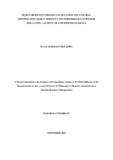HUMAN RESOURCE STRATEGY EVALUATION AND CONTROL, INFORMATION CHARACTERISTICS AND PERFORMANCE IN HIGHER EDUCATION: A SURVEY OF UNIVERSITIES IN KENYA
Abstract
Along with the debate on universities as specific organisations is the drive for adoption of
marketlike practices among which the strategy process is prominent. The primacy of the
human factor in higher education institutions privileges human resource initiatives. The
human resource strategy is particularly significant. Theoretically, human resource strategy
actualises business strategy; but evidence for its practicality is scarce. This brings to the fore
strategy evaluation and control. Although strategy evaluation and control is vital in corporate
and business strategy discourse, it is apparently less so for human resource strategy. Extant
literature indicates lack of evidence of use of strategy evaluation and control in human
resource strategy. Thus, the purpose of this study was two-fold: to domesticate the business
strategy evaluation and control dimensions to human resource strategy in universities in
Kenya; and to establish the relationship between utilisation of those dimensions and the
performance of the human resurce strategy, directly and indirectly through the mediation of
information characteristics and the moderation of top management support. The rationale of
this inquiry was to narrow this gap in the literature. This study was considered important to
top management and human resource specialists for the need to show the strategic role of
human resource systems and practices by justifying their worth in harnessing the human
potential. Five theories supplied the constructs and explanations: the strategic management
model; data, information, knowledge and wisdom model; role theory; systems theory; and
institutional theory. These anchored evaluation and control deimensions, information
characteristics, top management support, and performance constructs respectively.
Institutional theory underpinned context. The study, a cross-sectional sample survey, was
carried out in Kenyan universities, a population of 74 from which the investigator drew a
probability sample of 34 using a table of random numbers. The unit of analysis was the
human resource function and Registrar (Administration) the respondent. Data was collected
using a self-administered questionnaire tested for reliability and validity on 12 univerisites.
The researcher mailed the instrument to 34 vice chancellors for approval and completion by
the registrars, achieving a 94% response rate. Data was processed using the Statistical
Package for Social Science (SPSS) Version 25 with AMOS 21 and analysed using descriptive
and inferential statistics. Six hypotheses were tested at 5% level of significance. The direct
relationship between human resource strategy evaluation and performance was positive and
significant (r = .61, p{0.000}< 0.05; b = .61, p{0.000}) as was the direct relationship
between human resource strategy control and performance) (r = .71, p{0.000}< 0.05; b =
.71, p{0.000}). In mediation, partial correlation between human resource strategy evaluation
and performance was moderate and significant (r = .34, p{0.034}< 0.05). Sobel’s test for path
analyses was significant (z = 2.86, p{0.000}< 0.05). Partial correlation between human
resource strategy control and performance was moderate and significant (r = .60, p{0.000}<
0.05). Sobel’s test for path analyses was significant (z = 3.31, p{0.000}< 0.05). Moderation
of top management support on human resource strategy evaluation-performance link was not
significant (b = .006, p{0.749}) as was moderation of top management support on human
resource strategy control-performance link (b = -.001, p{0.959}). The conclusions were:
business strategy evaluation and control dimensions were relevant and positively influenced
performance; information characteristics mediated the direct relationships, and top
management support was more to management support eas found undesirable. Policy
recommendations included using the dimensions in performance management. Future studies
could include employees, heads of departments and other members top management
members as well as use mediated moderation and moderated mediation.

